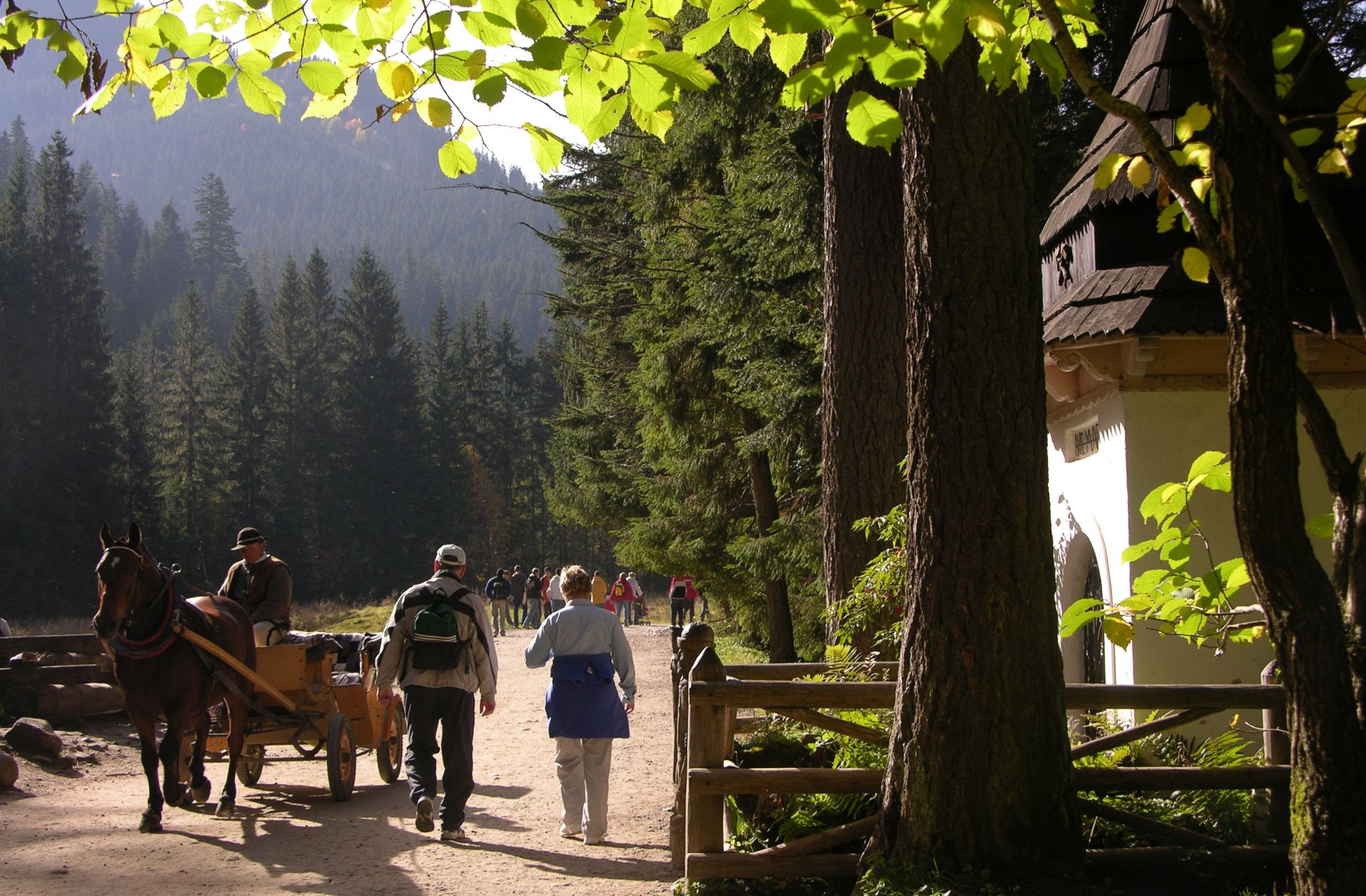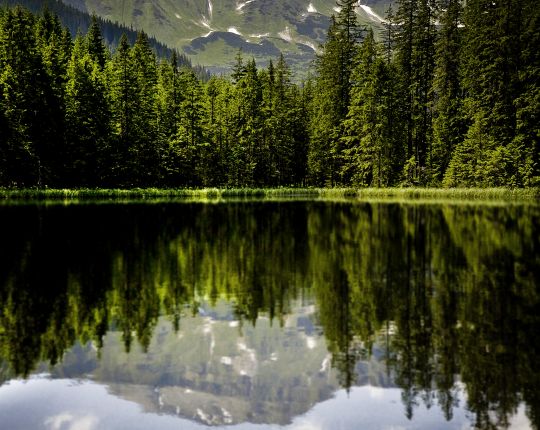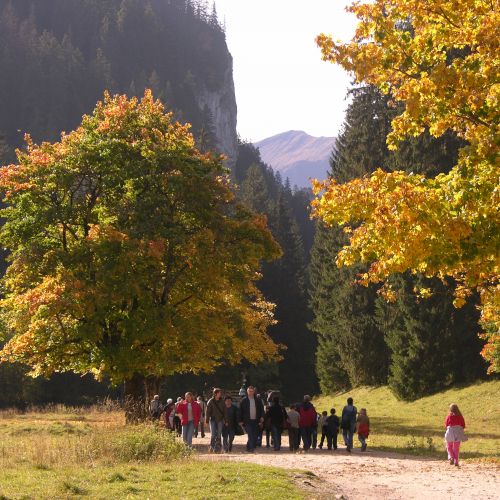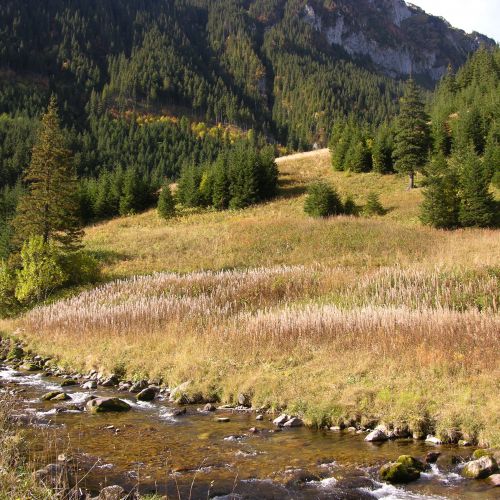Kościeliska Valley has many
enthusiasts. It's considered as one of the most beautiful tatra
vales, full of natural richness and historical memorials. Going
through this valley do not give us any difficulties during winter
time. However, it's recommended to wear suitable footware and take
flashlight because of shorthened day. Path to shelter can become a
great chance for cross-country skiing. Years ago it was one of the
favorite ski spot, which held its central landmark in Pyszna Hall
shelter, openened in year 1909, currently shut down.
We start our trip in Kiry. We can
leave our car, bike or bus on one of many paid parkings here. Kiry
have excellent transport connection to Zakopane and surrounding
villages: Witów, Chochołów, Czarny Dunajec. At valley's exit many
restaurants, guesthouses and Tatra National Park info boards are
placed. Tourists can also hire a cab (even sleds), which will
transport us from the valley's outlet, far into Pisana Clearing.
Kościeliska Valley entrance (TPN
territory) requires payment, which is charged on place. The walk
towards Ornak Hall Shelter goes along Kościelisko Stream at first.
After passing Niżna Kościeliska Brama, also known as Kantak Gate,
we enter wide clearing – Wyżnia Kira Miętusia where cultural
sheep grazing is being held. We can try sheep milk products (cheese,
żętyca) in local huts. After a while we reach the point where the
trails spread: black on Przysłop Miętusi (Regle Path fragment), red
through Adamica on Czerwone Wierchy, and our own trail, facing Ornak
Hall Shelter (specifically on Mała Polanka Ornaczańska). After not
so long, through the vale bottom, green and black trails go together,
but before Zbójnicka Chapel, the black one goes right, towards
Kominiarski Przysłop, Lejowa Valley and Chochołowska Valley.
We, however, go to Stare Kościeliska.
Formerly it was a very lively place. It's because there were mining
and steel industry buildings, forester's lodge, later tavern and
small shelter of count Władysław Zamoyski located here. Today there
are no traces left after these monuments. The only exception is blast
furnace foundation ruin, indicated by memorial board. After heavy
snowfalls it might be barely visible.
On the southern end of Stare
Kościeliska we find trail branching: black one leads to Mroźna Cave
(closed during winter), blue, labeled in year 1892 by Mieczysław
Karłowicz (mountaineer, photographer, composer) to Stoły Clearing.
Right after trail turns to Stoły, we go through Pośrednia Brama
Kościeliska (Kantak Gate), and shortly pass the place to which leads
the descending trail from Mroźna Cave.
In over a dozen
minutes we get to Pisana Clearing. Besides wooden benches and tables
(often covered after snowfalls), where you can take a rest, there is
also cab's final stop. Because of visual valors, Pisana Clearing
region is very popular among tourists, who usually take souvenir
photographs here. Limestone rocks, visible here and there, are
exceptionally impressive, with massive Kominiarski Wierch rising
above the clearing and Kościeliski Stream, writhing nearby. Behind
the clearing, after crossing the small, wooden bridge, we pass Cracov
Gorge entrance, which ends with a cave known as Dragon's Cavity. The
yellow trail leads us inside the gorge, however cave passage is
extremely dangerous in winter. We go further down the Kościeliska
Valley bottom, we pass Wodna Cave under Pisana exit, Mylna Cave
descent and also, in Wyżnia Kościeliska Brama region, trail start
leading to the caves: Raptawicka, Obłazkowa and beformentioned
Mylna. Likewise, those caves are not recommended in winter because of
their steep approach.
From this point the valley expands
slightly which means we're entering glacier-transformed terrain.
Soon, on the right side, in forest, Wincenty Pol Cross and Smytna
Valley outlet should be visible on the elevation (avalanche hazard
after large snowfalls!). After 10-15 minutes we reach trail
divergence. The black trail starts here and leads to Smreczyński
Pond in 30 minutes. This trail, visually pleasing and safe in winter,
can get us to one of the more colorful Tatra region.
Our green
trail turns left, leading through Tomanowa Valley to Chuda Przełączka
(Czerwone Wierchy). This section is closed in winter, however. If we
want to arrive at PTTK Shelter on Ornak Hall, we should go straight
the yellow trail, and get there in couple of minutes. We return to
Kościeliska Valley exit with the same way.
 Bardzo dobra
Bardzo dobra









